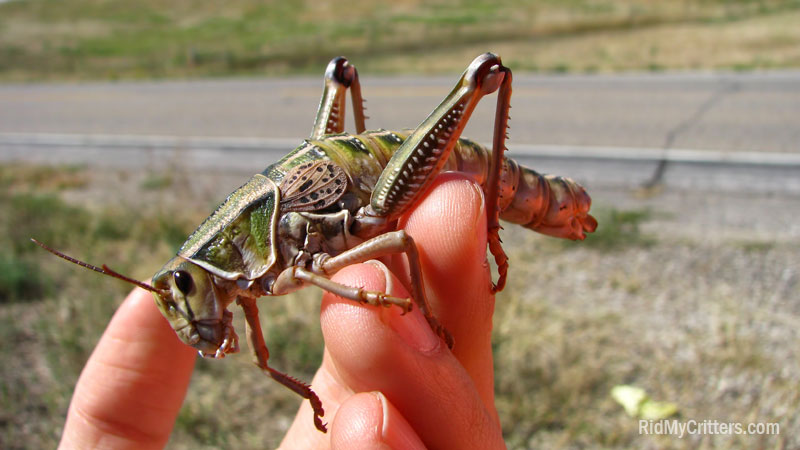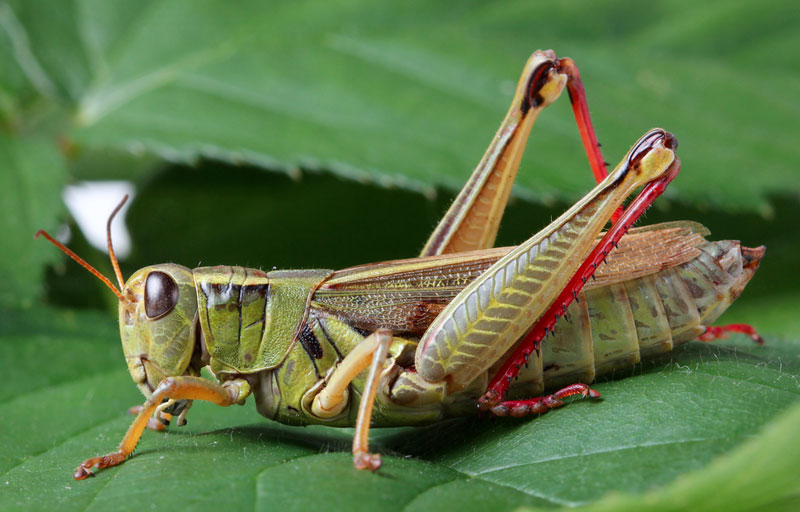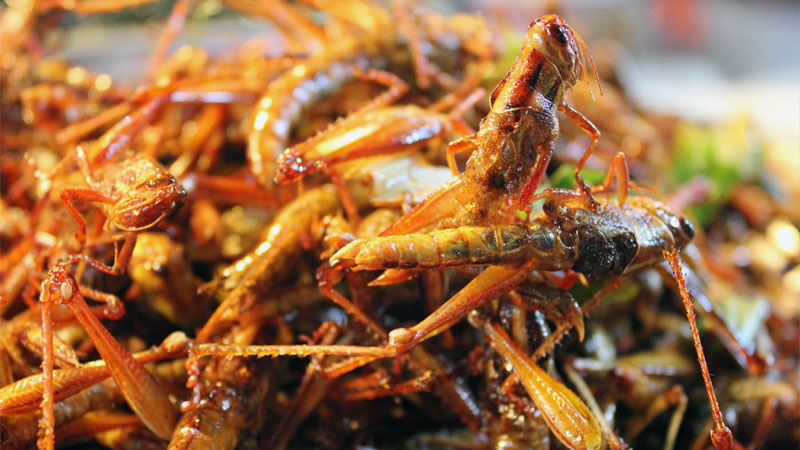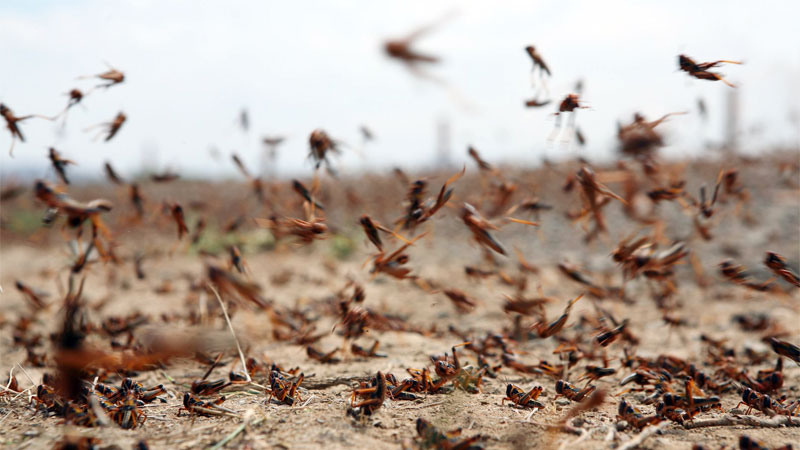Grasshoppers are an interesting lot. They can be a pest in gardens or even a threat to farms, so getting rid of grasshoppers is often necessary. However, they also hold a high place in world cultures.
There’s a lot to talk about with these common insects. Let’s pull up some of the most fascinating facts about grasshoppers and get to appreciate this humble critter in new ways.
See Also: 9 Fascinating Facts About Wolf Spiders
Facts About Grasshoppers
#1 – The Body Makes the Man, erm, Insect
Grasshoppers have an interesting body design with several adaptations you might not have heard about. While the details can vary a bit between species, these adaptations make the grasshopper seem almost alien.
Sensory Organs
Grasshoppers actually have five eyes. The two compound eyes are obvious, but there are also three ocelli (or simple eyes) between them. They have two filiform antennae which are shorter and a little thicker than those of crickets. It’s believed the sensory bristles on the ends of these antennae serve as the grasshopper’s nose.
To make things even more fun, grasshoppers actually have their auditory organs in the first segment of their abdomen. These consist of a simple eardrum known as a tympanal organ. The organ allows them to sense intensity and rhythm.
Each species has its own rhythm for mating calls. However, as they cannot differentiate pitch, it can be truthfully said that all grasshoppers are quite tone-deaf.
Limbs
The hind legs of a grasshopper are elongated and designed to allow these critters to jump long distances. They also have two pairs of wings, with the forewings being more leathery and designed primarily to cover and protect the more delicate hind pair. These are all attached to the thorax, which itself actually has three segments.
Much like crickets, many species of grasshoppers can use their legs to make sound. They have peg-like appendages on the inside of their hind legs. By beating these on the thickened edges of their forewings, then can produce little percussion sounds.
Coloration
The coloration of grasshoppers actually varies quite a bit, despite them mostly being depicted as green. This coloration ranges from yellow to brown, and primarily serves as a form of camouflage.
Interestingly enough, nutritionists have noted a slight difference between brown and green species in mineral content. In a few species, this coloration is quite vibrant, warning potential predators that these critters have a diet that includes toxic plants.
Those hunters that ignore this visual warning will be ingesting poison stored within the grasshopper’s body.
#2 – Food for Thought
While it seems to be a running joke that outdoorsmen eat chocolate covered grasshoppers, the truth isn’t far off. Grasshoppers are easy to prepare and are a highly beneficial source of protein.
Ze Boogs vs Ze Meat
Thanks to limited agricultural land availability, meat supply can’t meet demand in some countries. To make matters worse, the World Economic Forum (WEF) recently began pushing to limit livestock in European countries such as Belguim and the Netherlands. Their claim is that meat causes climate change, so people need to switch to an insect-based diet.
This silly claim led to a rather humorous farmer’s revolt in 2022. It’s also led to quite a few memes regarding ” eating ze boogs”. Ironically, the World Health Organization (WHO) had been attempting for years to get Americans to add insects as an alternate food source to augment the meat supply.
Insects are a common food in many countries around the world, but much of the US is grossed out by it.
Grasshopper Nutrition
A handful of crickets or grasshoppers can rival a steak for dietary requirements.
A single 3.5 ounce serving of grasshoppers contains an average of 26 grams of protein, 6 grams of fat, and 5 grams of carbohydrates. In addition, they have trace amounts of several valuable minerals, including: calcium (27.4mg), iron (16.6mg), niacin (2.1mg), phosphorus (140.9mg), potassium (370.6mg), riboflavin (1.2mg), and zinc (17.3mg).
Polyunsaturated fats abound, while saturated fats and cholesterol are almost nonexistent. When ground and mixed with water, the hind legs have shown an ability to help treat kidney disease. There is a slight variation in amounts of nutrients present between green and brown species.
Menu Options
While grasshoppers may be eaten raw, there are a wide variety of dishes that can be created. They may be sautéed, roasted, dehydrated, ground into a powder for use in baking, put on skewers on their own or as part of kebabs, or used in place of animal proteins in a wide range of both common and gourmet foods.
In Hebrew culture, those who take the vow of a Nazerite, such as John the Baptist, commonly consume locusts and honey as part of their diet. Insects are also popular throughout the Orient and among aboriginal and native peoples all over the world.
#3 – The Hero Called Hopper (and Other Stories)
Few creatures have inspired more children than the humble grasshopper. These summertime critters can be found throughout media, sometimes as heroes in bright colors, and sometimes in reference to historic plagues.
Some Heroes Have Antennae
Famed manga-ka (manga artist) Ishinomori Shotaro created manga’s first anti-hero, Skull Man, in 1970. This was a very dark and psychological story that Ishinomori couldn’t tell on television.
Instead, the television show he was co-creating needed a less scary concept. The artist turned to his son, Onodera Jo, for inspiration. The young boy suggested a grasshopper, and the rest is history.
Not only did the original Kamen Rider TV show last 98 episodes starting in early 1971 and feature two grasshopper-themed riders, it spawned a massive franchise that still runs strong to this day with a new 40-52 episode series airing every year since 2000 and spanning three of Japan’s imperial eras.
The first series of the current Reiwa Era, Kamen Rider Zero-One returns to the grasshopper motif, with the hero having forms based on a grasshopper and locust.
Elsewhere in Media…
But despite being one of Japan’s biggest multimedia juggernauts, Kamen Rider doesn’t hold the exclusive rights to the grasshopper theme. Popular children’s stories, fables, a line of educational books, and other media featuring grasshoppers abound.
One of the original Insecticons from Transformers, a grasshopper named Kickback has made numerous appearances in recent Transformers toy and game lines, often reprising his original grasshopper form.
Beyond physical appearances, grasshoppers are often referenced in quotes, the most famous of which is “Patience, young grasshopper” from a 1970s show called Kung Fu. The phrase most likely applies to the Chinese symbology of grasshoppers representing luck or a blessing.
The grasshopper in Western moral stories often portrays them as greedy, impatient, or irresponsible (such as in the famous Aesop fable The Ant and the Grasshopper).
#4 – Mass-Hoppers
There are over 11,000 known species in 2,400 genera of grasshopper in the world, covering every continent except Antarctica (although they may have been primitive grasshoppers there before Pangea broke apart).
They hail from the order Orthoptera, which is split into the suborders Caelifera (grasshoppers) and Ensifera (crickets, katydids, etc.). This split is quite recent, geologically, occurring during the devastating Permian-Triassic (P-Tr) extinction event 250 million years ago.
Most grasshopper species are either solitary or communal, with the latter forming swarms when food becomes scarce. These species are then referred to as locusts and become devastating to crops as they sweep through in search of food. In Biblical-era literature, the term locust is used more universally to describe both lone grasshoppers and swarms.
The biggest locust swarm on record occurred in 1875 by members of the Rocky Mountain locust species. This swarm measured 1,800 miles long and 110 miles wide. It comprised of an insane 3.5 trillion individuals!
Related: How to Get Rid of Locusts
#5 – (Almost) Older than Dirt
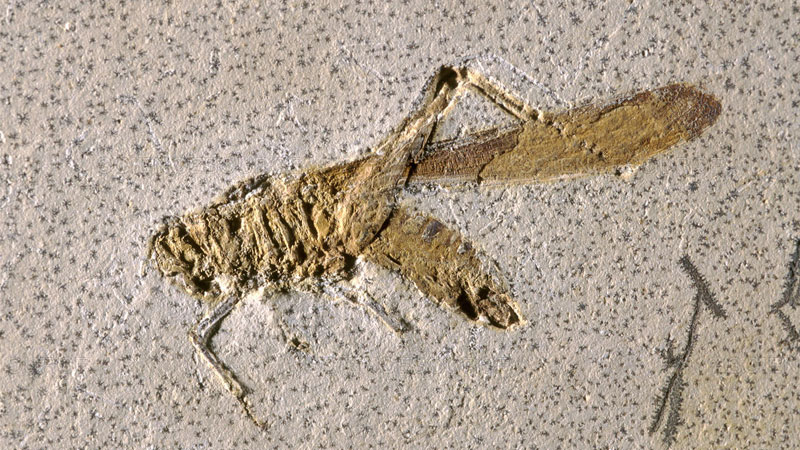
According to the fossil records, grasshoppers predate even the dinosaurs. Their ancient ancestors survived the P-Tr event when an estimated 83 percent of all insect genera were eradicated. While the oldest known fossils are about 3.5 billion years old, these are mostly very simple organisms or ocean life.
Orthoptera fossils can be dated back to the Carboniferous Period, over 300 million years ago. These fossils show just how successful Orthopteras are, with cricket and grasshopper fossils from this period showing very little difference between ancient and modern biology.
After the Permian period, the worst mass extinction event in Terran history wiped out more than half of all life on the planet. Orthopteras, however, continued to survive and the first split between Ensifera and Caelifera happened during this time.
The earliest Caelifera families are now extinct, but the first true grasshoppers are estimated to have arrived around 252 million years ago. This means they were dinosaurs to most of the dinosaurs!
#6 – Super Powers
Some grasshopper species have very unusual abilities. For example, members of the South American family Pauliniinae have the ability to skate on water or swim, and are primarily nocturnal (a quality more associated with crickets).
Lentulidae cannot fly, but they can jump just like their kin. And speaking of jumping, many can fly incredibly long distances as needed, which means a human-sized cricket could easily prove a match for Superman. Additionally, some species can consume poisonous plants or disguise themselves as leaves.
When taking to the skies, a grasshopper’s powerful jumping legs let it leap 10 times its length high and 20 times its length in distance. Not quite as high as a camel cricket, but to put it in perspective, if we had the same ability, the average person could jump the length of an American football field in one leap and Michael Jordon would be an average joe unless the hoops were put on towers.
These leaps also help it take to wing, which it does at an incredible 20Gs (that’s more than twice the maximum force for the best jet fighter in the world). In-flight speed is about 8 miles per hour which, considering their size, equates to a plane ride for humans in comparison.
#7 – Tobacco
One popular defense mechanism associated with grasshoppers is their ability to spit a pungent brown liquid when being handled. While it is unclear whether this is truly a defense or just a bad habit, the popular nickname for this spit is “tobacco juice”.
This is due in part to its appearance, but also because there has been a long-standing association between grasshoppers and tobacco plants.
#8 – Life and Love
Grasshoppers begin as an egg, one of hundreds, in fact. Grasshopper nymphs resemble an adult, but require a number of moltings to reach full development and size. Adults range in length from .4 to 2.75 inches, with females generally being larger than the males.
Males attract their potential mates by either vibrating their wings or rubbing the wings along their hind legs. Unlike crickets, a grasshopper’s mating call more closely resembles a percussion instrument. The female can identify a male of her species based upon the characteristic rhythm he plays.
Females have a somewhat short ovipositor but produce several hundred eggs after a mating. These eggs are able to withstand the winter months. However, grasshoppers themselves don’t fare well in the cold, and species in less temperate climates won’t survive past their first year. In tropical zones, the lifespan is much longer, with species living as long as seven years.
#9 – Farm Fury
Grasshoppers are a hot topic among farmers. On the one hand, they provide a great alternative to meat for vegetarians and can be bred easily. On the other, hungry migratory species can devastate a corn or tobacco crop in a matter of hours with no easy way to ward them off. Considering a grasshopper eats half its body weight daily, a small swarm can ruin a small field.
As grasshoppers prefer grass, they’re more likely to be found near grassy fields than forests. Maintaining a balance between pest and produce may be one of the most important concerns in coming years for the agricultural community, especially with the growing number of vegetarians worldwide and the growing shortages in meat production.
#10 – Home is Where the Food is
Grasshoppers deposit their eggs into the ground, not bothering with nests or burrows. This is due to the fact that they’re almost always migrating to the next food source. Even solitary species will migrate over long distances rather than allow the food supply to become completely depleted where they’re currently at.
#11 – It’s a Life-Eat-Hopper World Out There
Humans aren’t the only species to make a meal of grasshoppers. Ants, birds, lizards, praying mantises, wolf spiders, wasps, chipmunks, and other critters all love the nutritional feast a grasshopper provides.
In addition, the eggs are a source of food for bee flies and various beetles. They’re also susceptible to a range of fungi and bacteria. This is why females lay so many eggs, yet we’re not constantly being swarmed.
#12 – Robo-Hopper
When designing robotics, two of the most common early inspirations have been arachnids and grasshoppers. The number of legs provide superior stability and locomotion, while the overall shape of a grasshopper is easy to replicate.
Grasshopper-based robots are sometimes sold in toy or electronics stores now that technology has advanced to support bipedal designs in laboratories.
#13 – The ZedHopper
Straight out of a horror movie or edition of Ripley’s comes our final and perhaps most shocking fact: grasshopper zombies! As with many insects, grasshoppers are known to be infected by parasitic species which hijack their host.
Spinochordodes tellinii (commonly referred to as the nematomorph hairworm) is a freshwater species of parasite that particularly loves grasshoppers. Once inside a host, the larvae begin feeding off of the unsuspecting grasshopper, slowly taking over its brain.
By the time it reaches adulthood, the hairworm is several times the length of its host and has full control over its body. The zombified grasshopper is guided to the water where it drowns and the hairworm emerges.
But Wait… There’s More!
Today, we’ve looked at how grasshoppers can affect people without food, for better or worse. We’ve discussed how they’ve created pleasant childhood memories across generations and cultures. But there’s so much more to tell.
For example, there are big differences between the short-horned grasshoppers and long-horned grasshoppers besides the lengths of their antennae. There are species that have unique shapes which look like sticks or leaves.
And then there’s the difficult balance between the way grasshoppers benefit many scientific fields, while their eating habits prove a problem in agriculture.
Indeed, it would take a novel to fully describe how amazing (and frustrating) grasshoppers are. We’ve only covered a few facts here, so be sure to let us know if you have any fun facts we’ve missed (including on specific species).
- How to Get Rid of Hawks - March 8, 2024
- How to Get Rid of Pill Bugs (Rolly Pollies) - March 1, 2024
- How to Get Rid of Groundhogs (Woodchucks) - February 5, 2024

